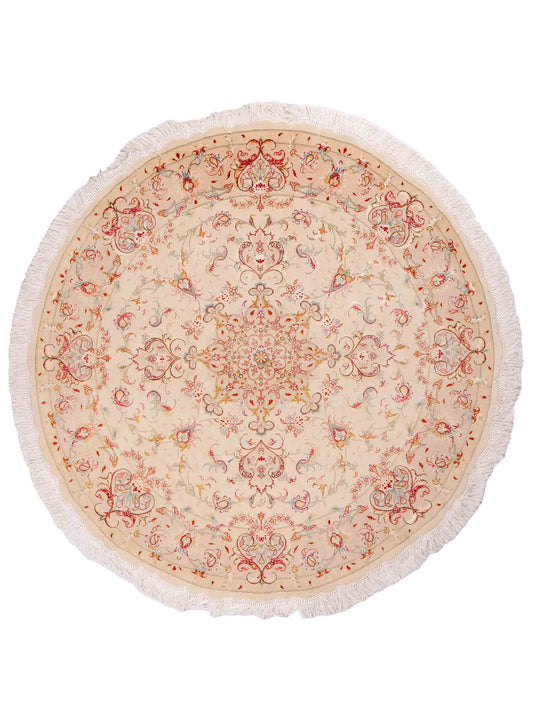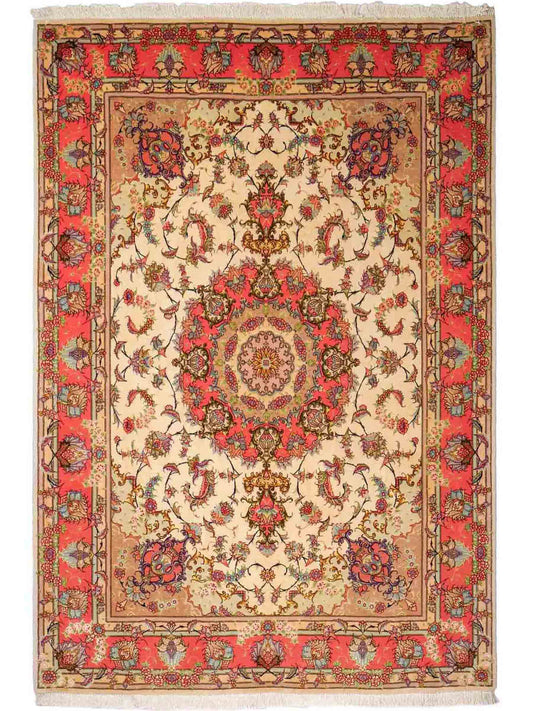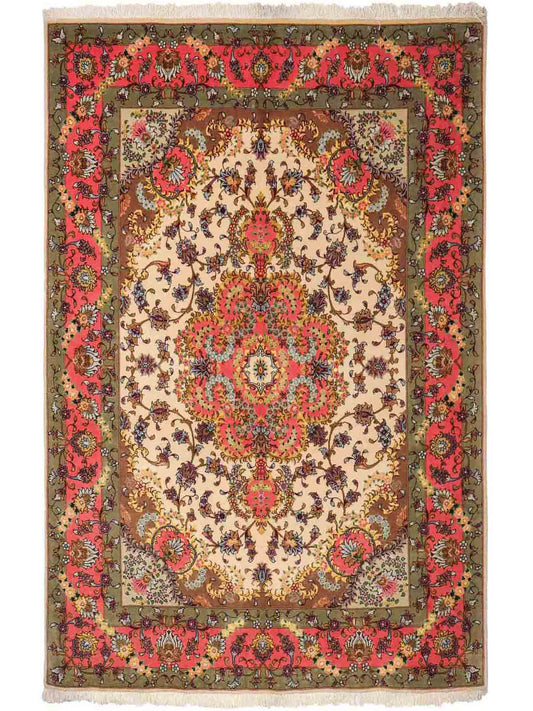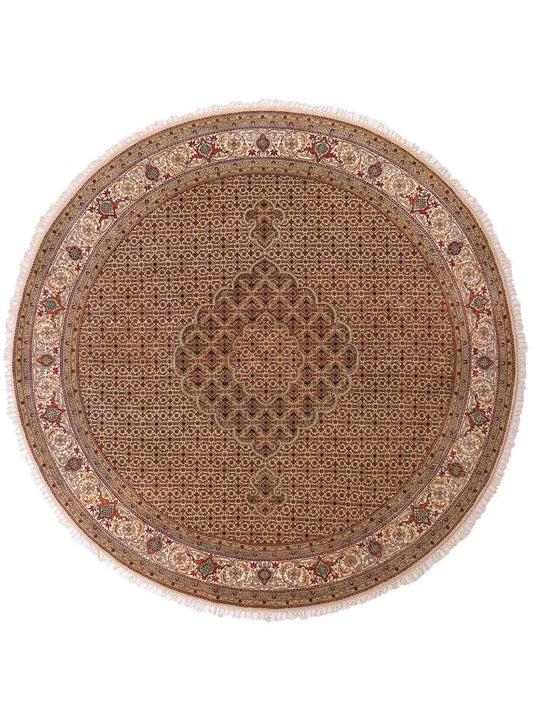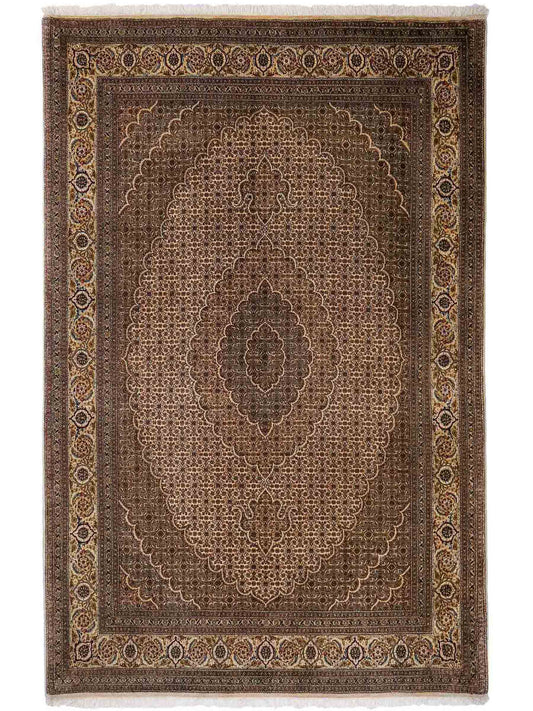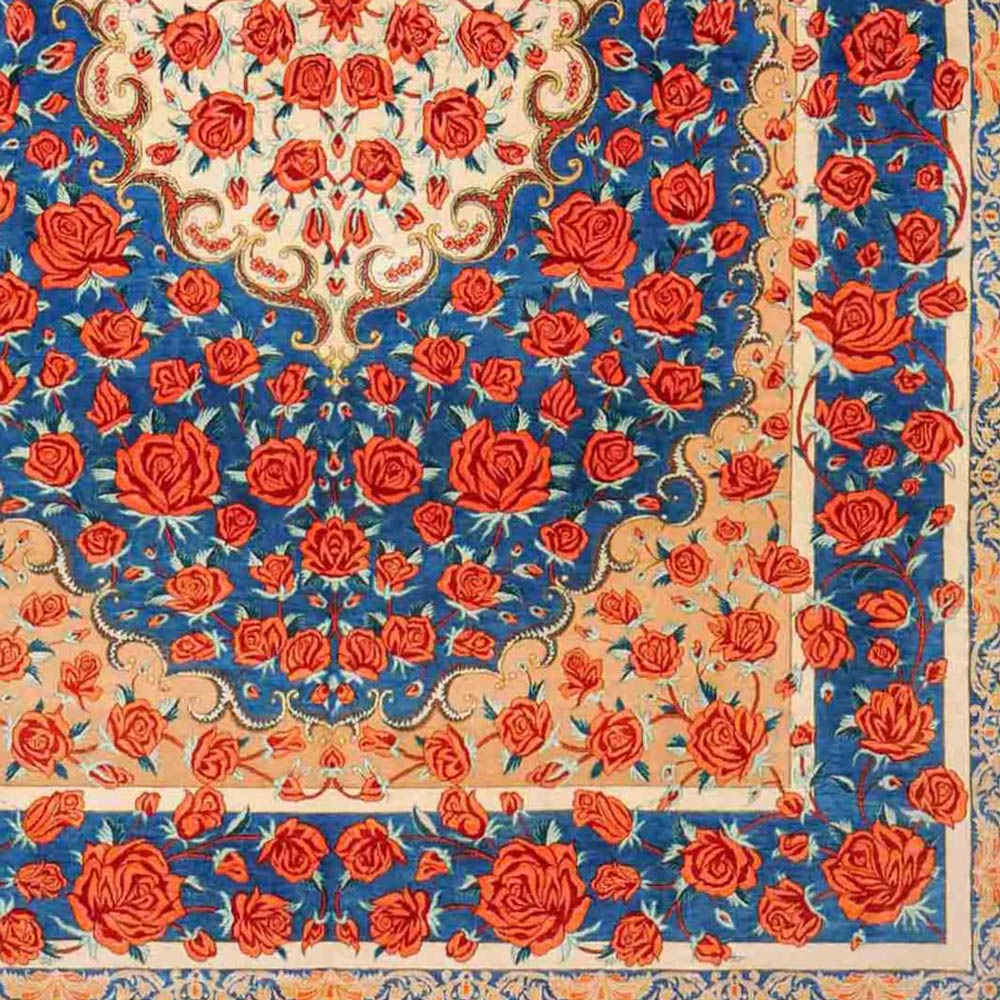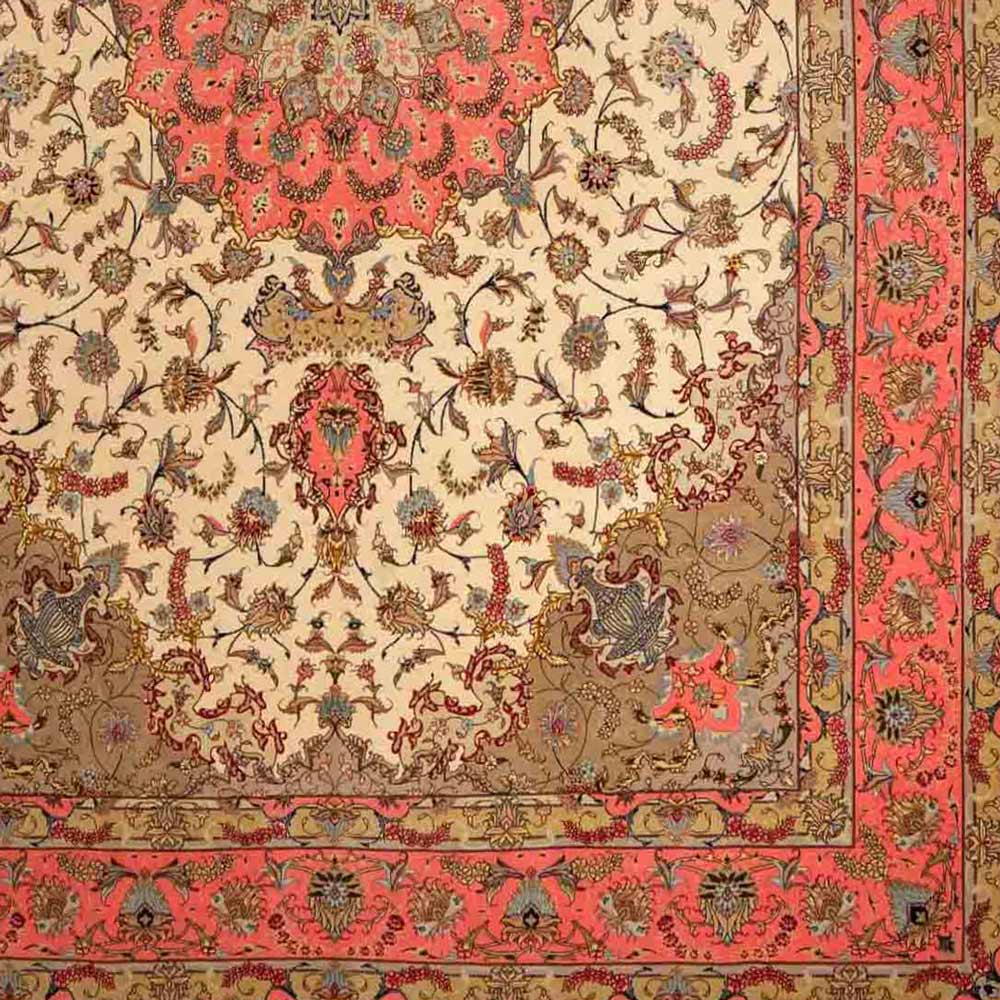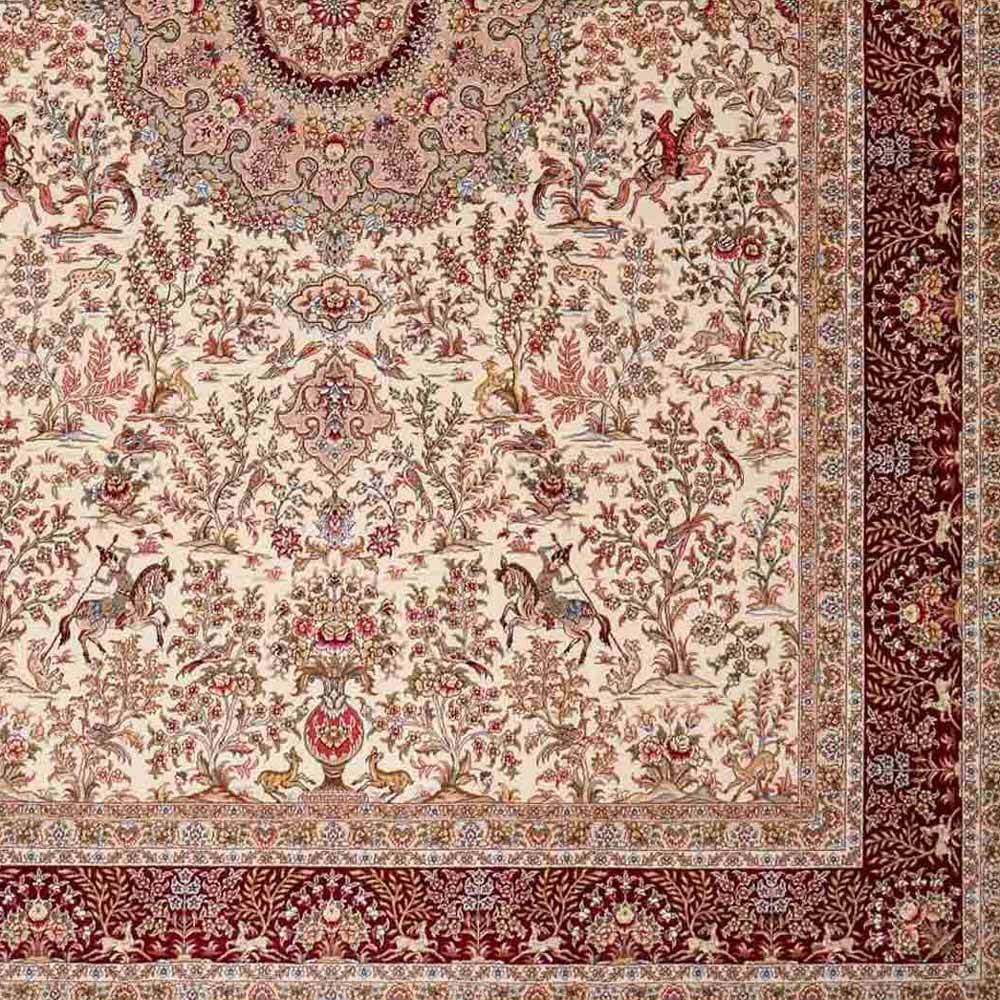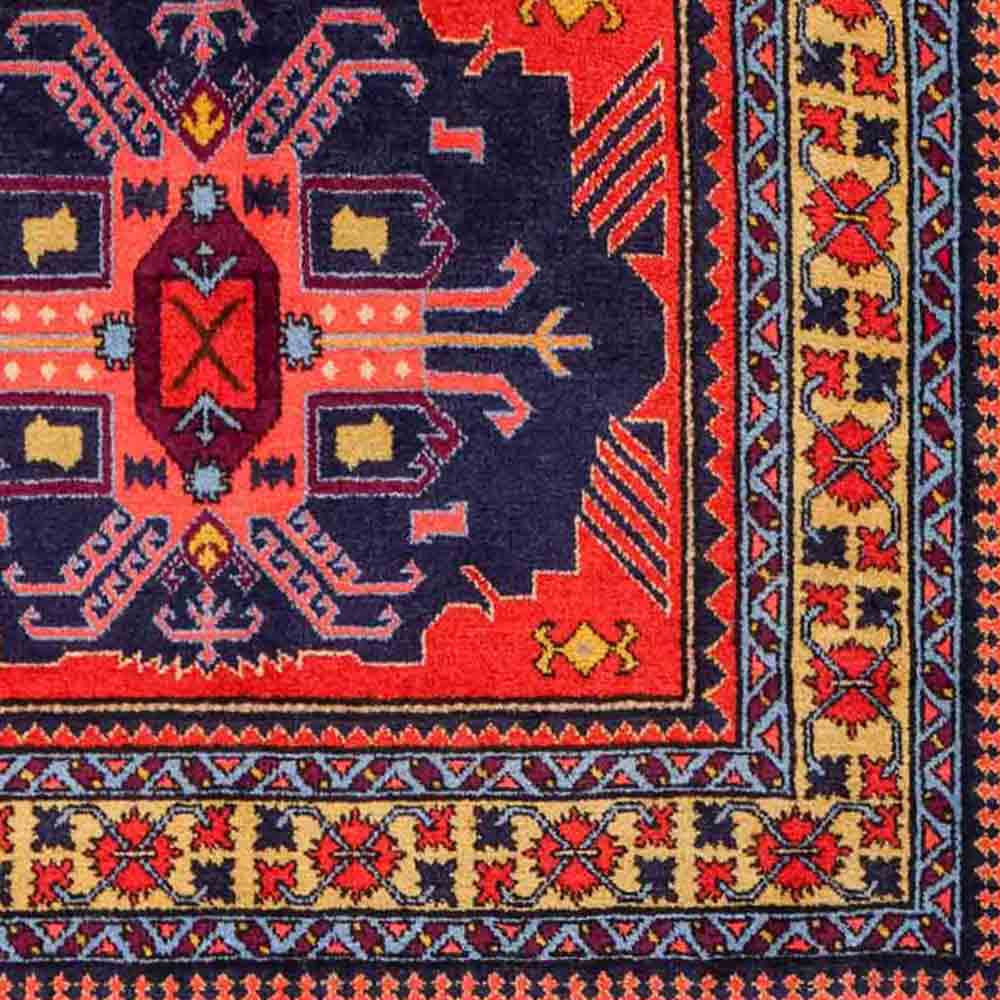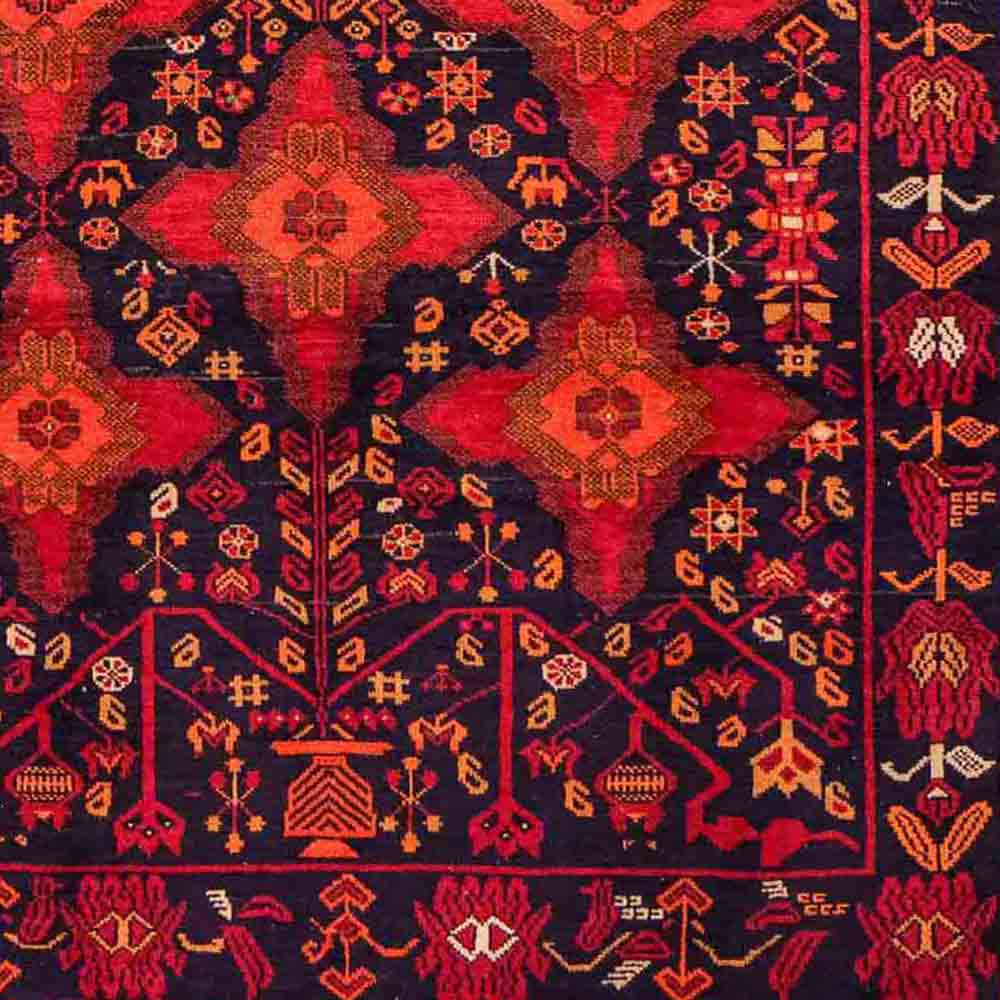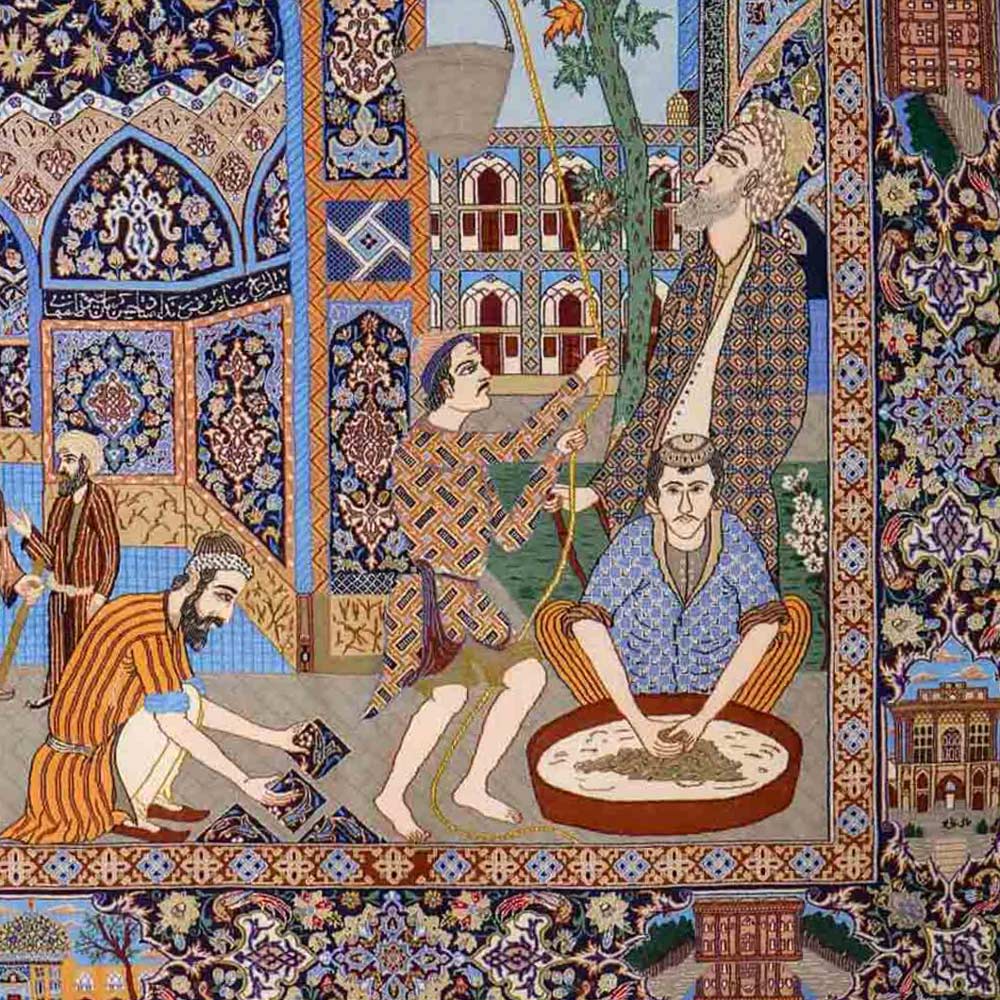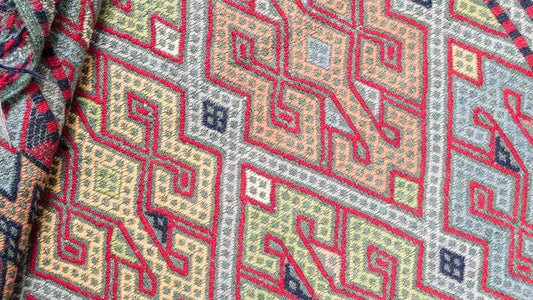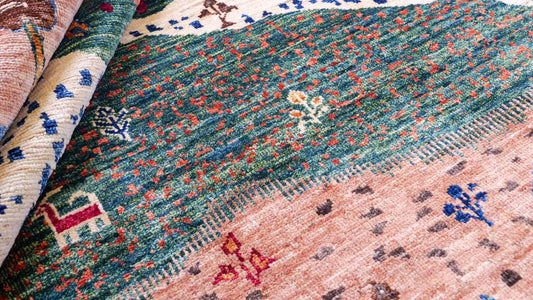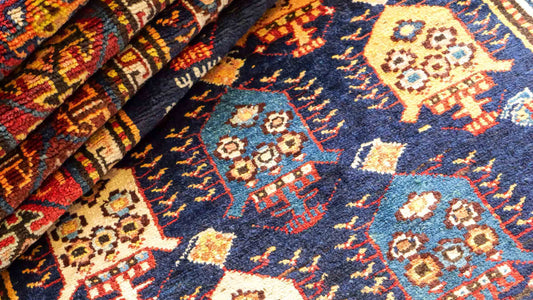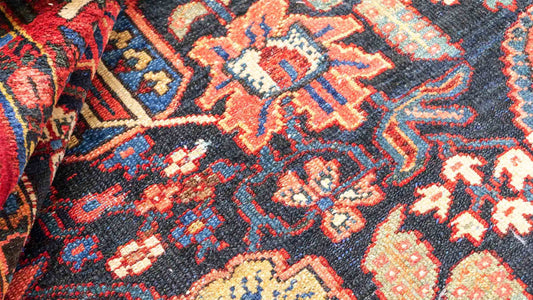
Tabriz
Daniel KhademiWelcome to the elegant world of Tabriz rugs, where centuries-old traditions meet masterful craftsmanship and creative design. Discover everything about the history, quality, typical patterns, care, and investment potential of these unique Persian carpet classics.
Tabriz Rugs: Key Facts at a Glance
- Origin: Tabriz, capital of East Azerbaijan Province, in northwestern Iran
- Materials: High-quality wool, silk highlights, natural plant-based dyes
- Design: Medallions, floral motifs, geometric patterns, figurative & tableau designs
- Knot Density: Varies from approx. 150,000 to 1,200,000 knots/m²
- Quality: Precise craftsmanship, high durability, exclusive details
- Value: Collector’s item, proven value retention, sought-after one-of-a-kinds
- Care: Gentle cleaning, avoid direct sunlight, care tips below
- Investment: Heritage & craftsmanship – coveted works of art on the world market
Explore our curated collection of exclusive Tabriz Rugs & Designs —find your one-of-a-kind masterpiece today!
Geography & Origin: A Center of Carpet Weaving
Tabriz is the capital of East Azerbaijan province in Iran, located in the northwest near the borders with Armenia and Turkey. This strategic location has made the city a vital trading hub, providing access to premium materials and facilitating cultural exchange. Tabriz’s geographical position not only shaped historic trade routes but also furthered the development of its carpet weaving tradition, linking diverse cultures and practices.
The area around Tabriz is defined by a varied landscape of mountains, valleys, and fertile plains. The nearby Alborz and Zagros mountain ranges provide an impressive backdrop as well as minerals used in carpet production. These ranges contribute to the region’s mild climate, which offers optimal conditions for growing plants used in natural carpet dyes. Especially in the surrounding fertile territories, crops like indigo, pomegranates, walnuts, and a variety of dye plants flourish—essential for producing Tabriz rugs’ characteristic, vibrant, and long-lasting colors.
Tabriz is also advantaged by an ingenious ancient irrigation system, namely the Qanat, which ensures sustainable watering of farmland. These underground water channels represent engineering mastery and play a crucial role in agriculture, yielding the natural fibers and dyes fundamental to Tabriz’s distinctive rug quality.
These favorable geographic conditions have been essential to Tabriz’s evolution over centuries as a world-renowned carpet center. Thanks to abundant natural resources, traditional expertise, and exceptional craftsmanship, Tabriz has produced rugs celebrated throughout Iran and across the globe. The city has preserved its storied history and artisanal prowess while embracing modern trends and demands—remaining a top destination for collectors and craft enthusiasts alike.
The History of Tabriz Rugs: From Safavid Courts to Design Classics
The art of carpet weaving in Tabriz dates back to the 15th century, a vibrant era of cultural flourishing. Under Safavid rule, the city became a center for high-quality rugs. Tabriz artisans perfected their techniques, creating unique designs distinguished by intricate patterns and vivid colors. By the 19th century, Tabriz had become one of the world’s most celebrated carpet centers, with global influence and recognition.
A key aspect of Tabriz rug artistry is the influence of the Balaghani school in the 18th and 19th centuries. This school was renowned for rugs of incredible density and detail—talented craftsmen refined many techniques, using fine wool and silk threads to produce masterpieces treasured worldwide.
Additionally, Tabriz rugs often carry cultural narratives and symbols. Their designs reflect myriad influences, including Chinese and Turkish elements—testimony to centuries of trade and cross-cultural contact. Animal figures, mythological creatures, and historical scenes commonly appear, telling stories rooted in the region’s traditions.
Tabriz’s location also made it a central hub on ancient trade routes, especially the legendary Silk Road. This position allowed the city to source both materials and artistic ideas from all over the world. Tough Anatolian wool and elegant Chinese silk patterns combined to shape the unique Tabriz rug aesthetic.
Today, while Tabriz’s rug industry faces challenges from globalization and fading interest in traditional crafts, numerous initiatives aim to keep the art alive. Local workshops offer apprenticeship programs that combine old techniques with modern designs, appealing to both older and younger generations. Workshops and educational programs help new artisans master the craft, ensuring the tradition endures.
Social and Economic Importance of Tabriz Rugs
For Tabriz weavers, rug making is much more than a livelihood—it’s a vital part of cultural identity. Many work in family businesses or small workshops, passing down valuable skills from generation to generation. The art of knotting demands considerable skill and dedication; artisans devote countless hours to producing high-quality carpets. They take pride in their heritage and creations, which are often cherished as family heirlooms. Their craftsmanship preserves cultural values and strengthens community identity.
Tabriz rugs are far more than mere décor; they are integral to Iranian culture and society. These carpets not only beautify homes but are also used at celebrations like weddings and religious events, representing the residents’ refined taste and cultural sophistication. Their diverse designs—often blending tradition with modernity—reflect the rich, dynamic history of Iran. The appreciation and use of Tabriz rugs help sustain the community’s collective memory and cultural identity.
Economically, Tabriz rugs are a key sector for both the local and national Iranian economy. They enjoy high global acclaim and demand, fueling a thriving export trade. This not only generates jobs in carpet production but also stimulates industries such as wool and dye manufacturing. The high standards and reputation of Tabriz rugs cement their value on international markets. Local fairs and exhibitions also make these artisans’ creations accessible to wide audiences, encouraging exchanges between makers, traders, and buyers, and boosting interest in these exquisite rugs.
Craftsmanship & Precision in Production
The production of Tabriz rugs is an intricate, time-honored tradition demanding the highest standards, remarkable skill, and significant commitment—sometimes taking many months or even years.
- Material Selection: Each Tabriz rug begins with a loom, the foundation of its structure. Craftspeople carefully select materials to ensure the hallmarks of Tabriz quality. High-grade wool is most often used for the pile, usually sourced from local sheep breeds prized for their softness, durability, and color retention. In many Tabriz rugs, wool is combined with fine silk for special highlights, structure, and visual depth, with silk often used for the warp, fringes, and intricate details—lending the carpets shimmering elegance.
- Knotting Process: Next comes the skilled knotting, as artisans set knots one by one with painstaking precision. Knot density is a key indicator of quality—Tabriz rugs span a range of 150,000 to 1,200,000 knots (or more) per square meter. Higher knot densities allow for more detailed patterns and greater durability, while lower densities may result in simpler designs.
- Finishing: In the final phase, the rug undergoes various finishing processes: washing to remove dirt and loose fibers, then trimming edges and adding decorative stitching to reinforce the structure and create a refined finish.
All together, the Tabriz rug creation process is a successful fusion of tradition, craftsmanship, and the finest materials, resulting in unique pieces that are both aesthetically remarkable and highly functional.
Tabriz Designs & Motifs: Symbolism and Creativity
Tabriz rugs are celebrated for their variety and stunning beauty. Each piece tells its own story and reflects Iran’s deep cultural heritage. From striking medallion designs and delicate florals to geometric patterns and figurative artwork—every motif is a harmonious blend of artistry and cultural symbolism.
- Medallion Designs: Tabriz rugs often feature pronounced central medallions in bold colors, richly ornamented with filigree details. These medallions act as the focal point of the entire composition, framed by floral and geometric patterns that lend a sense of harmony and balance.
- Floral Motifs: Floral patterns are among the trademarks of Tabriz rugs and often form the basis for many designs—roses symbolizing love and beauty, elegant lilies representing grace, and stylized regional flowers for a connection with nature and seasonal cycles. These motifs are usually symmetrical and balanced, lending the rugs a calming presence and cultural depth.
- Geometric Shapes: Geometric patterns—rhombi, triangles, rectangles—are central to Tabriz rugs, creating visual structure and stability. Often symmetrically arranged, they bring order and rhythm to the designs.
- Figural Elements: Figurative motifs may depict human figures in traditional attire or classic Persian architectural or archaeological themes. These scenes add to the visual variety and reflect the values and traditions of Persian society.
- Tableau Designs: This special category features rare Tabriz rugs portraying narrative scenes—everyday life, historical events, or mythological tales—inviting viewers to immerse themselves in each carpet’s unique story. Such pieces are often exhibited in ceremonial spaces or museums as artistic and cultural artifacts.
Color Selection & Range in Tabriz Rugs
The Tabriz color palette is rich and varied, giving these carpets distinctive visual allure. Every shade is carefully chosen for symbolic meaning:
- Rose Tones: Soft, calming and romantic, symbolizing tenderness and love—often used in florals, creating warmth and charm.
- Gold & Cream: Associated with luxury and elegance. Gold accents provide opulence, while cream serves as a neutral backdrop, highlighting other hues and lending a sophisticated atmosphere.
- Reds: Denote happiness and prosperity, often appearing in central motifs. Vibrant reds draw the eye and energize a space—a key feature in many cultures.
- Blues: Stand for peace and tranquility, used to build harmonious transitions. Their calming depth is often linked to water and sky, ideal for meditative or restful rooms.
- Greens: Symbolize fertility and nature, adding lively freshness. A grounding, reassuring color, green supports natural and growth-related themes.
Tabriz colors are derived mainly from natural sources, such as plants, roots, and minerals, ensuring long-lasting, radiant hues. The artisans’ expertise guarantees well-coordinated combinations, bringing the carpets’ surfaces to life.
Tabriz Rugs Vs. Other Persian Design Classics
| Feature |
Tabriz | Bijar | Hamadan | Nain |
| Origin |
Tabriz (NW Iran, Azerbaijan) |
Bijar (Kurdistan, West Iran) | Hamadan (West Iran) | Nain (Central Iran |
| Material | Fine wool with silk | Very dense wool | Coarse to medium wool | Fine wool with silk |
| Knot Density | 150,000–1,200,000 knots/m² |
250,000–600,000 knots/m² |
100,000–300,000 knots/m² |
200,000–1,200,000 knots/m² |
| Designs/Patterns | Medallion, floral, geometric, tableau, figural | Robust, often heraldic, geometric/floral | Simple to geometric/floral | Floral, medallion, arabesque |
| Surface |
Smooth, often silky sheen | Extremely robust, thick, dense | Durable but coarser |
Soft, fine, lightly lustrous |
| Colors |
Rose, gold, red, blue, green… |
Red, blue, beige/ochre, strong |
Strong reds/blues, earth-tones |
Cream, blue, ivory, gold |
| Highlights |
Precision, variety, fine detail |
“Iron carpet” - legendary hardiness |
Everyday classic, affordable |
Elegance, high silk content |
| Value/Price Range | High, strong appreciation | Mid-high, extremely long-lasting | Entry to mid-range, good value | High, strong appreciation |
Checklist for Tabriz Rugs: Quality & Authenticity
- Is the rug made from premium local wool (possibly with silk)? ✔
- Is the knot density fine (minimum 150,000 knots/m²; premium >300,000)? ✔
- Are the patterns intricate, harmonious, often featuring a medallion or florals? ✔
- Are the colors luminous and well-balanced—does hand-dyeing show? ✔
- Are fringes and edges neatly crafted, free from factory seams? ✔
- Is there a certificate of origin/authenticity? ✔
- Is the back of the rug tidy with clean knotting, no loose spots? ✔
- Does it feel soft yet robust? ✔
- No chemical scent (proof of natural dyes)? ✔
- Are care instructions included? ✔
Tip: If all the boxes are ticked, you’re acquiring a genuine, long-lasting Tabriz masterpiece!
Care & Longevity: Preserving Your Tabriz Rug
To keep your Tabriz rug looking its best:
- Vacuum regularly, never beat the rug
- Blot spills immediately with lukewarm water & a cloth
- Avoid direct sunlight
- Professional cleaning every 1-2 years recommended
- Find more value & care tips in our blog post: *How to Care for Hand-Knotted Rugs*
Styling Tips: Decorating with Tabriz Rugs
Tabriz rugs suit classic or traditional interiors that value artistic flair and elegance. Use your Tabriz as a centerpiece in the living room, perhaps on a dark wood floor or in a warmly toned space, to show off the rug’s colors. They shine especially when paired with antiques and fine textiles.
When choosing a Tabriz for your home, consider the room’s size and color palette. A large rug under both sofa and coffee table unites the space and creates harmony. Emphasize the carpet’s shape with furniture in complementary or contrasting colors; ensure that upholstery patterns don’t clash with the rug. Keep wall colors neutral to let the Tabriz take center stage.
Tabriz Rugs as Collectibles & Investments
Purchasing a Tabirz rug means acquiring art, historic craft, and lasting value.
- Value Appreciation: Top-quality Tabriz rugs often gain value over time, thanks to intricate technique, rare materials, and unique designs. Well-preserved examples are prized by collectors and have remarkable investment potential.
- Collector’s Items: Tabriz rugs come in an array of styles and sizes to satisfy every collector’s taste. A thoughtfully chosen Tabriz rug tells stories, becomes a family heirloom, and enhances exhibitions or private collections for generations.
In an age of mass production and disposable goods, handmade treasures like Tabriz rugs grow ever more relevant and desirable.
► For detailed tips & in-depth guidance, see our blog post: *Are Hand-Knotted Rugs a Good Investment?*
Request a free personal style or purchasing consultation for Tabriz rugs today!
FAQ – Frequently Asked Questions About Tabriz Rugs
What makes an authentic Tabriz rug?
► High-quality wool/silk, precise craftsmanship, detailed medallion/floral patterns, certificate of origin.
How can I recognize a genuine Tabriz rug?
► Certificate of authenticity, clear back structure, premium materials, exquisitely rendered, symmetrical patterns.
Do Tabriz rugs appreciate in value?
► Exclusive, well-preserved Tabriz rugs with unique motifs regularly gain value and are highly prized investments. Read more in our blog: *Are Hand-Knotted Rugs a Good Investment?*
How should I care for a classic Tabriz?
► Gentle cleaning, professional care, never harsh sun/chemicals. More in our guide: *How to Care for Hand-Knotted Rugs*
Where can I safely buy genuine Tabriz rugs?
► Only from specialist dealers and reputable online shops—always check for certificates of authenticity and expert advice. At JUPITER Intl, every hand-knotted, hand-tufted, and handwoven rug comes with a Certificate of Authenticity.
Conclusion: A Timeless Fusion of Art and Culture
In summary, Tabriz rugs are a fascinating addition to any home. Decorative, long-lasting, valuable, and perfectly suited to everyday life—their artistic design, deep symbolism, and storied history give each one a unique identity. An absolute must for any carpet connoisseur.
Explore our curated collection of exclusive Tabriz Rugs & Designs —find your one-of-a-kind masterpiece today!
Related blogs & blog posts you might also be interested in:
→ Design Classics, Countries of Origin, Carpet Materials, Carpet Guide

